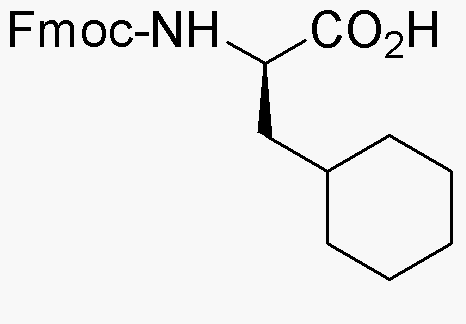Fmoc-b-cyclohexyl-D-alanine is widely utilized in research focused on:
- Peptide Synthesis: This compound serves as a key building block in the synthesis of peptides, particularly in solid-phase peptide synthesis, allowing researchers to create complex and functional peptide sequences efficiently.
- Drug Development: Its unique structural properties make it valuable in the design of peptide-based drugs, offering potential therapeutic applications in treating various diseases, including cancer and metabolic disorders.
- Bioconjugation: The compound can be used in bioconjugation processes, where it helps attach peptides to other biomolecules, enhancing the specificity and efficacy of drug delivery systems.
- Research in Neuroscience: Due to its ability to mimic natural amino acids, it is employed in studies exploring neuropeptide interactions, aiding in the understanding of neurological pathways and potential treatments for neurodegenerative diseases.
- Material Science: Fmoc-b-cyclohexyl-D-alanine is also explored in the development of novel materials, such as hydrogels, which can be used in tissue engineering and regenerative medicine, providing scaffolds for cell growth.
General Information
Properties
Safety and Regulations
Applications
Fmoc-b-cyclohexyl-D-alanine is widely utilized in research focused on:
- Peptide Synthesis: This compound serves as a key building block in the synthesis of peptides, particularly in solid-phase peptide synthesis, allowing researchers to create complex and functional peptide sequences efficiently.
- Drug Development: Its unique structural properties make it valuable in the design of peptide-based drugs, offering potential therapeutic applications in treating various diseases, including cancer and metabolic disorders.
- Bioconjugation: The compound can be used in bioconjugation processes, where it helps attach peptides to other biomolecules, enhancing the specificity and efficacy of drug delivery systems.
- Research in Neuroscience: Due to its ability to mimic natural amino acids, it is employed in studies exploring neuropeptide interactions, aiding in the understanding of neurological pathways and potential treatments for neurodegenerative diseases.
- Material Science: Fmoc-b-cyclohexyl-D-alanine is also explored in the development of novel materials, such as hydrogels, which can be used in tissue engineering and regenerative medicine, providing scaffolds for cell growth.
Documents
Safety Data Sheets (SDS)
The SDS provides comprehensive safety information on handling, storage, and disposal of the product.
Product Specification (PS)
The PS provides a comprehensive breakdown of the product’s properties, including chemical composition, physical state, purity, and storage requirements. It also details acceptable quality ranges and the product's intended applications.
Certificates of Analysis (COA)
Search for Certificates of Analysis (COA) by entering the products Lot Number. Lot and Batch Numbers can be found on a product’s label following the words ‘Lot’ or ‘Batch’.
*Catalog Number
*Lot Number
Certificates Of Origin (COO)
This COO confirms the country where the product was manufactured, and also details the materials and components used in it and whether it is derived from natural, synthetic, or other specific sources. This certificate may be required for customs, trade, and regulatory compliance.
*Catalog Number
*Lot Number
Safety Data Sheets (SDS)
The SDS provides comprehensive safety information on handling, storage, and disposal of the product.
DownloadProduct Specification (PS)
The PS provides a comprehensive breakdown of the product’s properties, including chemical composition, physical state, purity, and storage requirements. It also details acceptable quality ranges and the product's intended applications.
DownloadCertificates of Analysis (COA)
Search for Certificates of Analysis (COA) by entering the products Lot Number. Lot and Batch Numbers can be found on a product’s label following the words ‘Lot’ or ‘Batch’.
*Catalog Number
*Lot Number
Certificates Of Origin (COO)
This COO confirms the country where the product was manufactured, and also details the materials and components used in it and whether it is derived from natural, synthetic, or other specific sources. This certificate may be required for customs, trade, and regulatory compliance.


